

Electronics. Quantum computers. 10 Breakthrough Technologies 2020. Wearables. Cybersecurity. Statistics. AI. Augmented Reality. Digitization. Inovation. Interaction Design. Fiction and Technology. Internet. Nanotechnology. Not sure if good technology. Retro. Robotics. Toys. How Emerging Technologies Are Impacting Industries – The Startup. Technology Definitions Artificial Intelligence A branch of computer science that creates intelligent machines, which can perform activities such as speech recognition, learning, planning, and problem solving.
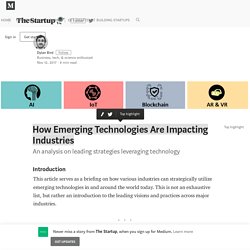
Machine learning — a core subfield of AI — provides the ability for systems to cognitively learn and improve from experience without being explicitly programmed. Internet of Things A network of physical objects — appliances, equipment, vehicles, devices, etc. — embedded with sensors, connectivity, and the capability to collect, exchange, and act on data, typically without human interaction. Researchers build an AI that draws what you tell it to.
If you’re handed a note that asks you to draw a picture of a bird with a yellow body, black wings and a short beak, chances are you’ll start with a rough outline of a bird, then glance back at the note, see the yellow part and reach for a yellow pen to fill in the body, read the note again and reach for a black pen to draw the wings and, after a final check, shorten the beak and define it with a reflective glint.

Then, for good measure, you might sketch a tree branch where the bird rests. Now, there’s a bot that can do that, too. The new artificial intelligence technology under development in Microsoft’s research labs is programmed to pay close attention to individual words when generating images from caption-like text descriptions. This deliberate focus produced a nearly three-fold boost in image quality compared to the previous state-of-the-art technique for text-to-image generation, according to results on an industry standard test reported in a research paper posted on arXiv.org. Telescopes – Infographics for the People. A comparison of primary mirrors.
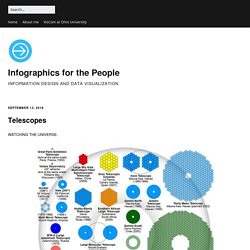
If a telescope has more than one mirror, the dotted lines show how large a single mirror would be (if it had the equivalent light-gathering ability). Below, some details of the three telescopes with the largest mirrors.Infographic by Cmglee (via Wikimedia). Overwhelmingly Large Telescope (OLT)Sadly this massive example (with its “this-is-what-it-is” name) has been canceled. The mirror would have been a shocking 328 feet (100 meters) in diameter. It could have captured images 1,500 times fainter than the faintest Hubble Space Telescope image. Image: ESO. Calibration – Infographics for the People. The Baotou Comprehensive Calibration and Validation Site in Inner Mongolia, China.

Each painted panel is 157 x 157 feet (48 meters). Below, one of the fifteen targets that are positioned in a row at Edwards Air Force Base, in California. Sometimes old aircraft have been placed near the target as part of the test. Vision and Language Intelligence - Microsoft Research. Decades of computer vision research, one ‘Swiss Army knife’ - The AI Blog. Quantum Simulation Could Shed Light on the Origins of Life. What role does quantum mechanics play in the machinery of life?
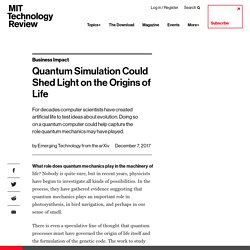
Nobody is quite sure, but in recent years, physicists have begun to investigate all kinds of possibilities. In the process, they have gathered evidence suggesting that quantum mechanics plays an important role in photosynthesis, in bird navigation, and perhaps in our sense of smell. Emerging Technologies. 5 Odd Moments in Tech History.
Over the centuries, the history of technology has accumulated very relevant moments, names and figures.
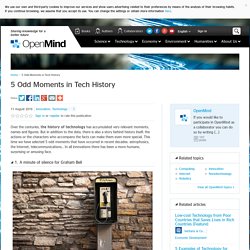
But in addition to the data, there is also a story behind history itself: the actions or the characters who accompany the facts can make them even more special. This time we have selected 5 odd moments that have occurred in recent decades: astrophysics, the Internet, telecommunications… In all innovations there has been a more humane, surprising or amusing face. 1. New Model Could Show That Stephen Hawking Is Right About Black Holes. One of the longest standing mysteries of black holes is what happens to stuff when it falls inside.

Information can’t move faster than light, so it can’t escape a black hole, but we know that black holes shrink and evaporate over time, emitting Hawking radiation. This has troubled scientists for 40 years. Information can’t simply vanish. EWAO Scientists: 'Impossible' fuel-free engine that defies the laws of Physics works. It works!

An ‘impossible’ fuel-free engine that defies the laws of Physics has been proven to work by numerous independent laboratories. However, researchers are still unsure as to how it actually works. Scientists are sure how it works since the so-called EmDrive defies all known laws of physics. Why are so many smart people such idiots about philosophy? There’s no doubt that Bill Nye “the Science Guy” is extremely intelligent.
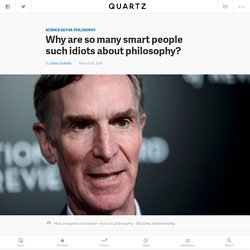
But it seems that, when it comes to philosophy, he’s completely in the dark. The beloved American science educator and TV personality posted a video last week where he responded to a question from a philosophy undergrad about whether philosophy is a “meaningless topic.” Robotics. Technology. What Technology Will Look Like In Five Years. NASA tests ‘impossible’ no-fuel quantum space engine – and it actually works. A study conducted last year by NASA scientists has become the latest, and by far the highest profile, piece of evidence in favor of a seemingly impossible space thruster design that’s been evoking worldwide skepticism for some time now.

Apparently annoyed by the persistent boosters of several similar but distinct designs, the space agency finally agreed to test an American-made variant called the Cannae Drive. “Alright!” ‘Impossible’ Quantum Space Engine Actually Works – NASA Test Suggests. Stephen Hawking: “Artificial Intelligence Could End The Human Race” But How? Artificial Intelligence Will Be Human Holocaust: Stephen Hawking. Artificial Intelligence: Does It Spell Our End? Stephen Hawking is the latest in a growing list of great thinkers who are warning us about the dangers of Artificial Intelligence (or A.I), with Elon Musk, creator of Tesla doing the same just a few weeks ago (you can read our article on it here).
Artificial Intelligence is a hotly debated topic, and, as we grow closer to a world where technology is developing at a rate faster than humans can keep up with, it is understandable that some of today’s great minds are warning us. According to an article on RT entitled, “Stephen Hawking: Artificial Intelligence could spell end of human race” [1], the author states: “World-famous physicist Stephen Hawking told the BBC he believes future developments in artificial intelligence (AI) have the potential to eradicate mankind.”
Stephen Hawking: 'Transcendence looks at the implications of artificial intelligence - but are we taking AI seriously enough?' - Science - News. Artificial-intelligence (AI) research is now progressing rapidly. Recent landmarks such as self-driving cars, a computer winning at Jeopardy! Why can't we see evidence of alien life? - Chris Anderson. PlanetQuest - The Search for Another Earth. Dr Paul Howard Jones - What is the Internet Doing to our Brains? Researchers Harness Brain Game Data. The activities of cognitive training enthusiasts give insight into the effects of lifestyle choices and age on the brain’s performance. Projects - Polytopia. $10,000 Car – That Runs On Air. Big Data: why is metadata more personal than our fingerprints.
A l’occasion du colloque « la politique des données personnelles : Big Data ou contrôle individuel « organisé par l’Institut des systèmes complexes et l’Ecole normale supérieure de Lyon qui se tenait le 21 novembre dernier, Yves-Alexandre de Montjoye (@yvesalexandre) était venu présenter ses travaux, et à travers lui, ceux du MediaLab sur ce sujet (Cf. « D’autres outils et règles pour mieux contrôler les données » ). Yves-Alexandre de Montjoye est doctorant au MIT. Il travaille au laboratoire de dynamique humaine du Media Lab, aux côtés de Sandy Pentland, dont nous avons plusieurs fois fait part des travaux.
Claire L. Evans: Greetings from the Children of Planet Earth. Does the Internet shape a disciplinary society? The information-knowledge paradox.